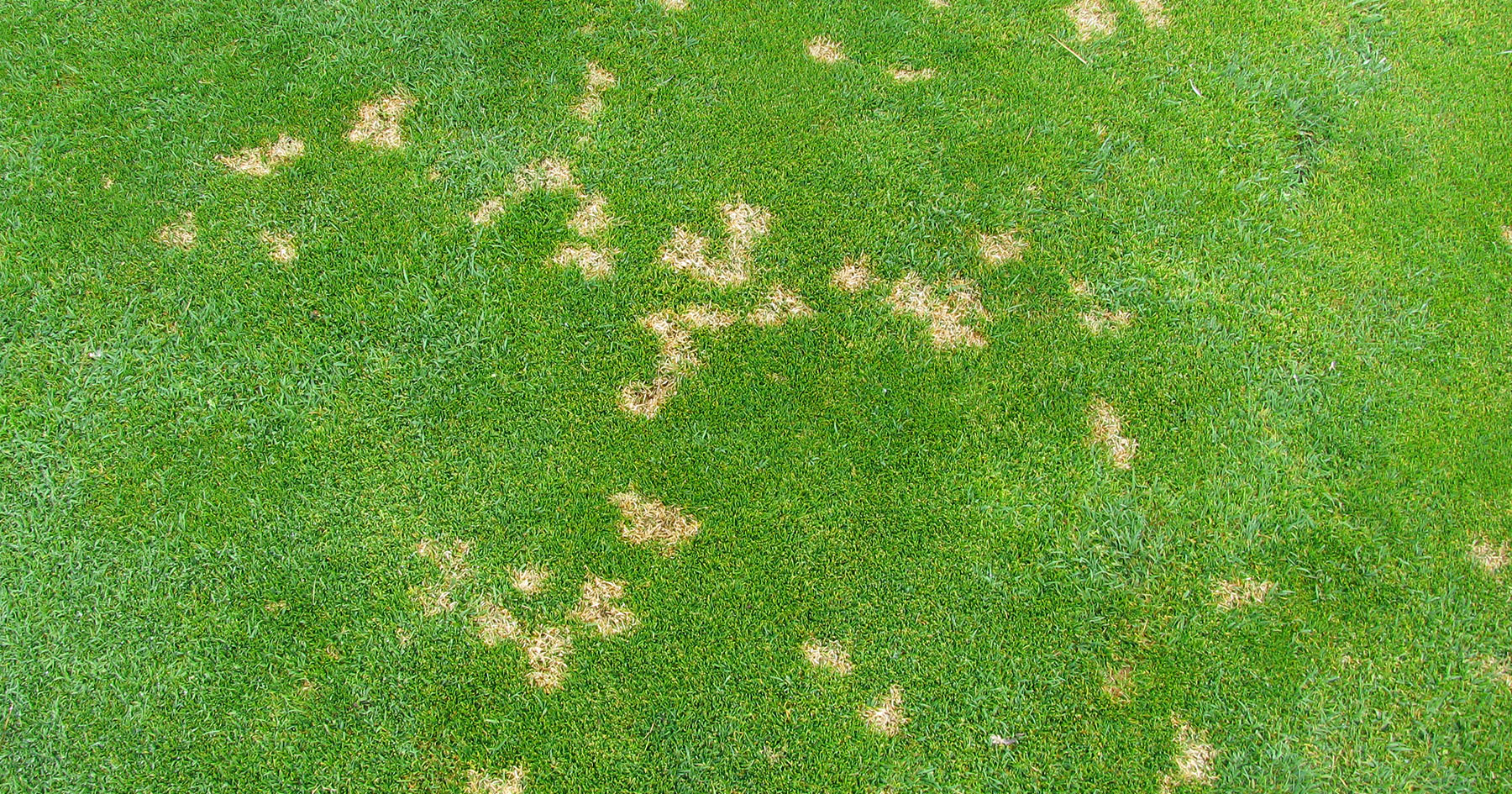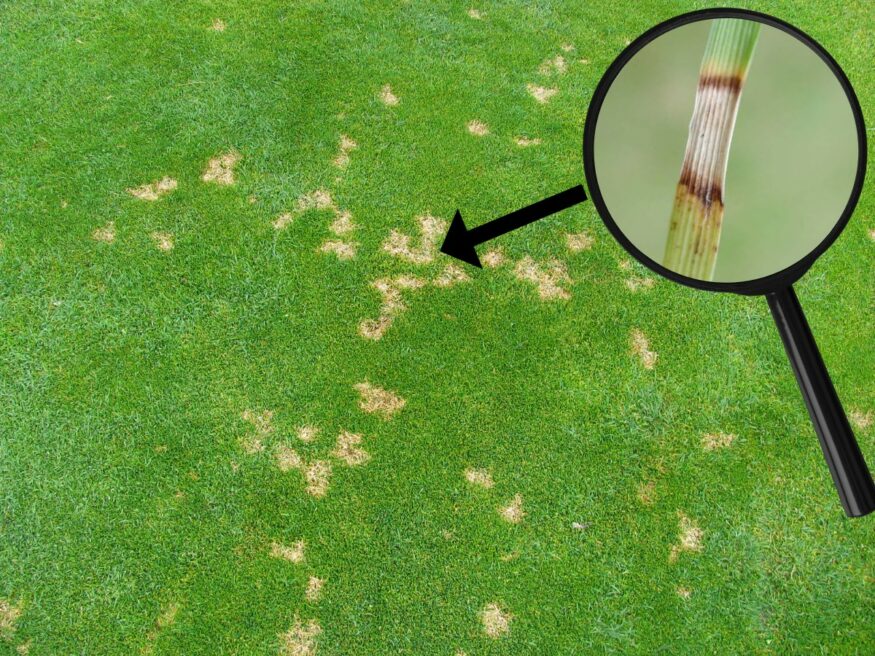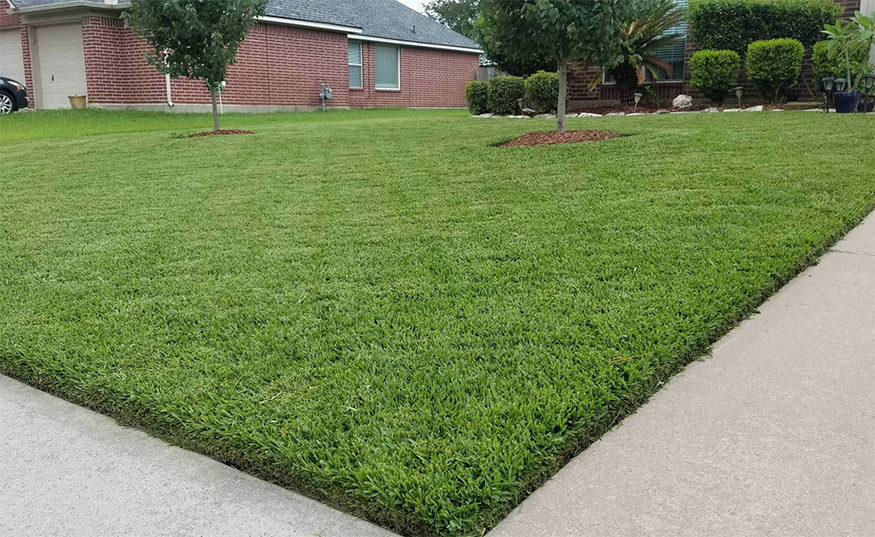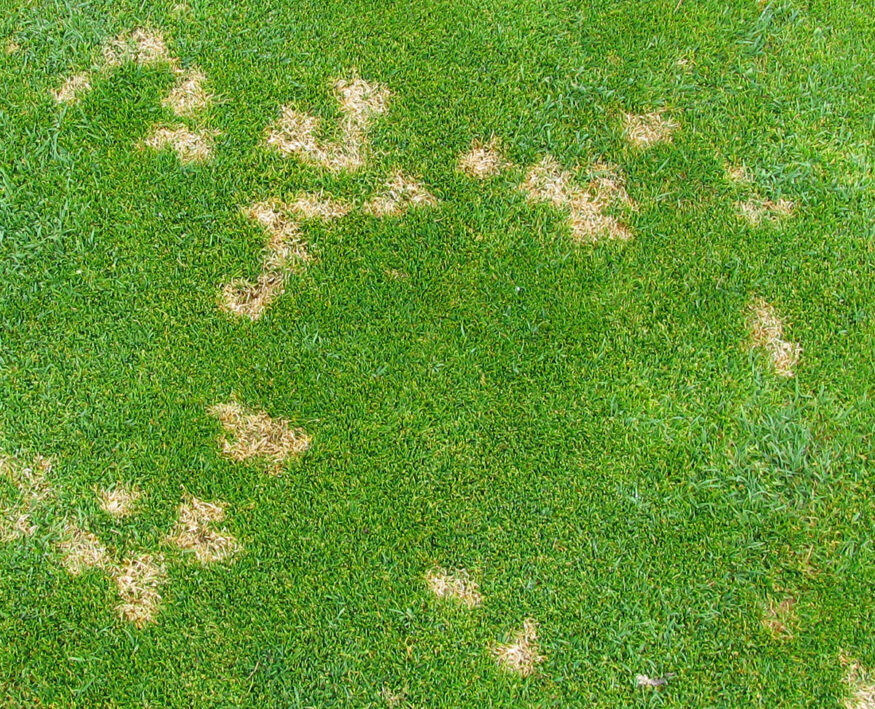Dollar Spot Fungus is a common fungal disease affecting various types of turfgrass, causing unsightly patches and potential damage to your lawn. This disease is caused by the pathogen Clarireedia jacksonii (formerly Sclerotinia homoeocarpa), which thrives in warm and wet conditions, making it essential to learn how to manage and effectively treat the fungus to maintain the health of your lawn.
Identifying Dollar Spot can be the first step in preventing widespread damage to your turfgrass. The clues lie in the appearance of small, round, sunken patches of straw-colored grass, reminiscent of a silver dollar.
Grass species like creeping bentgrass, perennial ryegrass, Kentucky bluegrass, and zoysia grass are particularly susceptible to Dollar Spot infections. By understanding the causes, susceptible species, and effective control methods, you can reduce the impact of this fungal disease on your lawn.
Key Takeaways
- Dollar Spot Fungus is a common turfgrass disease caused by Clarireedia jacksonii, requiring proper management and treatment.
- Identification involves spotting small, straw-colored patches on susceptible grass species such as creeping bentgrass, Kentucky bluegrass, and zoysia grass.
- Implementing cultural, chemical, and preventative strategies can contribute to effectively managing Dollar Spot in various turf settings.
[ez-toc]
Dollar Spot Fungus Identification
Symptoms
Dollar Spot Fungus is a common turf disease caused by the pathogen Clarireedia jacksonii (formerly Sclerotinia homoeocarpa). It primarily affects types of turfgrass such as creeping bentgrass, perennial ryegrass, Kentucky bluegrass, and zoysia grass.
The primary symptoms of dollar spot include straw-colored, circular patches with reddish-brown margins appearing on your grass. These discolored spots are typically the size of a silver dollar, hence its name. The infected plant parts, particularly the leaf blades, may also develop lesions.
Size
The size of these spots can vary, but they generally measure between 3 and 6 inches in diameter. These yellow to straw-colored spots on your grass blades can cluster together, creating larger patches of infected turf. It is crucial to identify and treat dollar spot early to prevent extensive damage to your lawn.
Appearance
Dollar spot fungus affects the grass blades, causing blotches and lesions on the leaf surface. Early stages of infection may display small yellow or light-green discolored spots on the leaves. As the disease progresses, these spots grow and eventually give way to the characteristic straw-colored, circular patches with reddish-brown margins.
A healthy and well-maintained lawn is essential in preventing and combatting dollar spot fungus, so be sure to monitor and strengthen your turf regularly.
Causes of Dollar Spot
Pathogen
Dollar Spot is a fungal disease affecting turfgrass, caused by the pathogen Clarireedia jacksonii (formerly Sclerotinia homoeocarpa).
This pathogenic fungus mainly targets creeping bentgrass, perennial ryegrass, Kentucky bluegrass, and zoysia grass but can also affect other types of grasses. The fungi produce mycelium and mycelia, which are responsible for the characteristic spots on the turf.
Climatic and Environmental Factors
Your lawn may become more vulnerable to dollar spot during certain climatic conditions. The disease thrives in wet, humid environments that are common during summer months, when high humidity and heavy dews persist.
Increased leaf wetness resulting from factors such as over-irrigation, late-day watering, or persistent heavy dew can promote the growth and spread of the fungus.
To minimize the risk of dollar spot in your lawn, it is essential to manage environmental factors.
- Be mindful of your irrigation practices, as excessive moisture can exacerbate the problem.
- Water your lawn in the early morning to allow the grass to dry throughout the day, which helps reduce the duration of leaf wetness and lowers the chances of fungal infections.
- In addition, proper air circulation can play a role in preventing the growth of dollar spot fungus, so ensure that your lawn has adequate space for air to circulate freely.
Implementing these practices can help maintain a healthy lawn and reduce the likelihood of dollar spot infections.
Turfgrass Species Susceptible to Dollar Spot
Dollar Spot fungus can affect a variety of turfgrass species, impacting their appearance and overall health. In this section, you will learn about the different types of grass that are vulnerable to this fungal disease.
Creeping bentgrass is particularly susceptible to Dollar Spot. This cool-season grass is commonly found on golf courses because of its fine texture and ability to tolerate low mowing heights. However, its dense growth and preference for moist conditions make it a prime target for the fungus.
To manage Dollar Spot in creeping bentgrass, it is crucial to maintain proper cultural practices such as aerification, balanced fertilization, and the use of fungicides when needed.
Perennial ryegrass and Kentucky bluegrass are also cool-season grasses that can be affected by Dollar Spot. These grasses are commonly used in lawns and sports fields due to their traffic tolerance and attractive appearance.
Unfortunately, their desirability also comes with vulnerability to various fungal diseases, including Dollar Spot. Proper irrigation, mowing, and fertilization practices will help maintain the health of your lawn and minimize the risk of infection.
Annual bluegrass, another cool-season grass, is often considered a weed in some turfgrass systems but can be desirable in others, such as golf courses. This grass can also fall victim to Dollar Spot, leading to a decline in its aesthetic value and playability. Implementing an integrated management plan is essential for controlling the disease and maintaining the quality of turf areas where annual bluegrass is present.
Dollar Spot can also affect warm-season grasses like Zoysiagrass. Zoysiagrass often grows in areas with high humidity and heat, where fungal diseases like Dollar Spot can thrive.
To protect your Zoysiagrass, keep an eye out for signs of infection and employ an integrated management plan that addresses the specific needs of your turf.
Both cool-season and warm-season grasses can be affected by Dollar Spot fungus. Some common species that are susceptible include creeping bentgrass, perennial ryegrass, Kentucky bluegrass, annual bluegrass, and zoysiagrass. By recognizing the grass species in your lawn or landscape and understanding their vulnerabilities, you can implement proper management practices to minimize the impact of Dollar Spot and maintain a healthy, attractive turf.
Cultural Management Practices
Mowing
Proper mowing techniques are essential in controlling dollar spot fungus on your turfgrass. Make sure to mow regularly at the recommended height for your specific lawn type, as this helps maintain the health and vigor of your turfgrasses.
Keep your mower blade sharp, which will reduce the stress on the grass and help prevent diseases like dollar spot from occurring. Additionally, removing leaf wetness early in the morning with dew whips, mowing, or lightweight rollers can help decrease the incidence of dollar spot (Delvalle et al. 2011).
Irrigation
To reduce the risk of dollar spot, it’s essential to water your lawn meticulously. You should aim to apply water deeply and infrequently, allowing the soil to somewhat dry between waterings. This will encourage deeper root growth and minimize the extended periods of wetness that can promote fungal diseases.
Also, irrigate early in the morning to reduce the amount of time that your lawn stays wet, which lowers the chances of dollar spot occurrence.
Fertilization
Fertilization is a vital component of dollar spot control. Using the appropriate amount of nitrogen fertilizer is crucial for maintaining disease-resistant turf. Over-fertilizing your lawn can lead to excessive growth, which ultimately increases its susceptibility to diseases like dollar spot.
On the other hand, under-fertilizing may result in less healthy turf, which is also more prone to infections. You should apply the right amount of fertilizer based on your turfgrass type and the soil conditions to maintain a healthy lawn (NC State Extension).
Thatch Removal
Thatch, the accumulation of dead plant material, can create an environment that encourages fungal growth. By regularly removing thatch from your lawn, you help decrease the chances of dollar spot and other diseases.
Thatch removal methods include dethatching with specialized equipment, or more commonly, aerating. Aerating your lawn allows water, air, and nutrients to reach the soil more easily, promoting healthy turfgrass and combating dollar spot.
Dollar Spot Treatment – Chemical Control Methods
Fungicide Applications
To control dollar spot fungus in your turfgrass, you can use fungicide applications as an effective treatment method. Chemical controls such as dithiocarbamate or benzimidazole fungicides typically control most infections within two weeks after application. However, repeat applications may be necessary if lesions continue to expand despite your treatment efforts.
When applying fungicides, ensure that you follow the label instructions carefully and adhere to the recommended rates. This will help in achieving the desired level of control against Clarireedia jacksonii, the causal fungus of dollar spot disease.
BioAdvanced Fungus Control is a good choice.
Resistance Management
Proper resistance management is crucial to the success of your chemical control efforts. The prolonged and repetitive use of the same fungicide can lead to resistance in the target pathogen, making your treatments less effective against dollar spot fungus. To avoid fungicide resistance, alternate between different chemical classes and modes of action in your fungicide applications.
Specifically, you should rotate between different active ingredients and avoid relying solely on demethylation inhibitors (DMI) or strobilurin fungicides. This will help in reducing the buildup of resistance in the fungal mycelium and fruiting bodies.
Contact and Systemic Fungicides
There are two main types of fungicides used for controlling turfgrass diseases: contact and systemic fungicides.
Contact fungicides protect the turf’s surface by remaining on the leaf blades and forming a protective barrier. This prevents the fungus from directly infecting the plant tissues. However, contact fungicides are not absorbed by the plant, so they may require more frequent applications to maintain effective control.
Systemic fungicides, on the other hand, are absorbed by the plant and transported throughout its system. This allows the fungicide to not only protect the turf surface but also target the fungus within the plant tissues. Systemic fungicides tend to have a more extended residual effect, which means they can provide longer-lasting control against dollar spot fungus.
By implementing these chemical control methods, you can successfully manage and prevent dollar spot fungal disease in your turfgrass and maintain its health and appearance.
How To Prevent Dollar Spot Fungus
Cultural Practices
To prevent dollar spot fungus in your golf courses, putting greens, and home lawns, adopt good cultural practices.
Ensure proper nitrogen fertilization, as the disease is more severe on turf with low nitrogen levels. Maintain adequate to high nitrogen fertility with light, frequent applications to reduce disease severity and promote recovery (source).
Prune trees and shrubs to improve air circulation and promote rapid drying of the turf.
You can also remove dew and guttation fluids by mowing, rolling, whipping, or poling greens early in the morning.
This will help reduce the chances of disease development, especially if Rhizoctonia or Pythium are present.
Resistant Cultivars
Incorporating resistant cultivars is another effective prevention strategy. When selecting turfgrasses for your golf course or home lawn, look for species and varieties that show resistance to dollar spot, such as some types of annual bluegrass and zoysiagrass. This will help reduce the need for additional treatments and contribute to overall turf disease management.
Preventative Fungicide Applications
Preventative fungicide applications can play a critical role in controlling dollar spot caused by Clarireedia.
Apply fungicides at the prescribed rate, particularly when weather conditions are at their peak for disease development (source). Tank-mix fungicides with various modes of action to enhance their effectiveness and help reduce the risk of the fungus developing resistance.
Follow label directions diligently and remember, preventative applications are crucial in keeping your turf healthy and free from dollar spot fungus.
Managing Dollar Spot in Different Turf Settings
Golf Courses and Putting Greens
Dollar spot is a common turf disease on golf courses, particularly on highly managed putting greens and fairways. To manage dollar spot on golf courses, ensure proper watering practices by watering deeply but infrequently in the early mornings.
Maintain an optimal cutting height of 3 to 4 inches for most grass types, except for zoysiagrass, which can be cut a little shorter but not less than 1 inch.
Additionally, avoid excessive thatch buildup that can harbor moisture and increase the risk of dollar spot infection.
Home Lawns
To manage dollar spot on home lawns, implement similar practices as mentioned for golf courses. Adjust your mower’s cutting height to the recommended 3 to 4 inches.
Make sure to water your lawn deeply but infrequently, primarily in the early mornings to prevent prolonged moisture on the grass, which can result in dollar spot infection.
Regularly monitor your lawn for signs of dollar spot, such as small, bleached-white or light tan spots, and take action to treat the disease if detected.
Athletic Fields
Athletic fields, especially those with highly managed turf, are susceptible to dollar spot infections. Proper turf management is crucial for the health of athletic fields. Make sure to:
- Adjust cutting height to 3-4 inches, depending on the grass type
- Water deeply but infrequently in the early mornings.
- Monitor fields for symptoms of dollar spot disease, such as bleached-white or light tan patches.
- Treat infected areas promptly to prevent further damage
By following these practices, you can effectively manage dollar spot disease on golf courses, home lawns, and athletic fields.
Dollar Spot Fungus Research and Advances
Clarireedia Genus
The dollar spot fungus, previously known as Sclerotinia homoeocarpa, is now classified under the Clarireedia genus as Clarireedia jacksonii. This fungal disease attacks highly managed turf stands worldwide, causing small, round, bleached to straw-colored spots on your lawn. As you might have experienced, dollar spot fungus is prevalent in North America and accounts for about 80% of all turfgrass diseases .
Current research on Clarireedia has led to a better understanding of the disease and the development of new approaches for its management . As you deal with dollar spot in your turf, it’s essential to know that this fungus thrives under specific conditions, such as night temperatures exceeding 50°F and extended periods of leaf wetness (10 to 12 continuous hours) .
Fungicide Resistance Issues
In recent years, dollar spot has shown resistance to certain fungicides, making it essential for you to carefully follow label directions when applying treatments. Researchers are continually working on understanding and addressing this resistance problem.
By staying up to date on the latest Clarireedia research, you can make well-informed decisions on how to deal with dollar spot fungus and protect your lawn from further damage. Keep in mind that implementing appropriate cultural practices and carefully selecting suitable chemical controls are crucial factors in managing dollar spot effectively.
More Reading
- Dollar Spot – Center for Agriculture, Food, and the Environment ↩
- What Kills Dollar Spot Fungus – Gardening Latest ↩
- New Approaches to an Old Problem: Dollar Spot of Turfgrass ↩
- Dollar Spot | NC State Extension – North Carolina State University ↩
Frequently Asked Questions
What is the best treatment for dollar spot?
To treat dollar spot, you can use fungicides specifically designed to target this type of fungus. Be sure to follow the label instructions carefully and apply it at the recommended rates. Additionally, it’s important to maintain proper lawn care practices, such as mowing at the correct height and watering properly to create an environment less favorable for the fungus.
Is it dangerous to humans or pets?
Dollar spot fungus is primarily a concern for lawn health and does not pose a threat to humans or pets.
How can I distinguish it from brown patch?
Dollar spot typically appears as small, round, straw-colored spots that measure between 3 and 6 inches in diameter, whereas brown patch often exhibits larger circular patches with dark brown margins. Dollar spot affected leaves have white or light tan spots, while brown patch leaves will have tan or light brown patches with dark brown borders.
Will the fungus disappear on its own?
Dollar spot fungus can continue to damage your lawn if left untreated. It’s essential to implement proper lawn care practices, such as maintaining the correct mowing height, watering appropriately, and applying fungicides if necessary, to help control the fungus.
What causes it to appear in lawns?
Dollar spot fungus thrives in warm, damp conditions and can appear in lawns if the grass is mowed too closely or if there is excessive moisture on the grass leaves. It can also develop due to nitrogen deficiency in the soil.
How can I prevent its spread?
To prevent the spread of dollar spot fungus, maintain proper lawn care practices, including mowing at the recommended height, keeping your lawn well-drained, and addressing underlying soil imbalances. Aerating your lawn can also help improve soil conditions and prevent the buildup of thatch, which can harbor the fungus.



